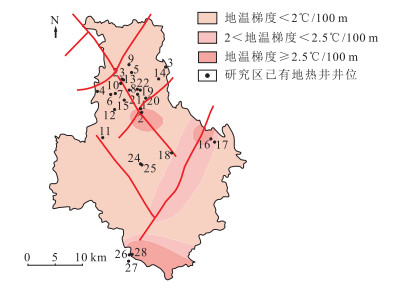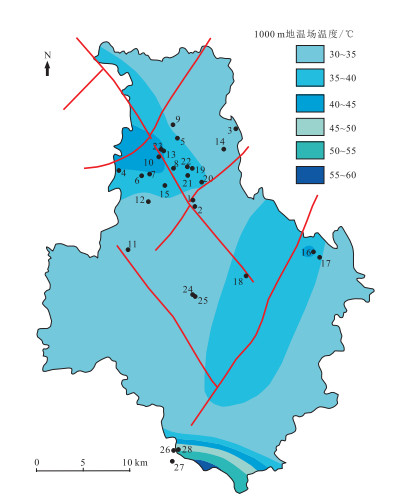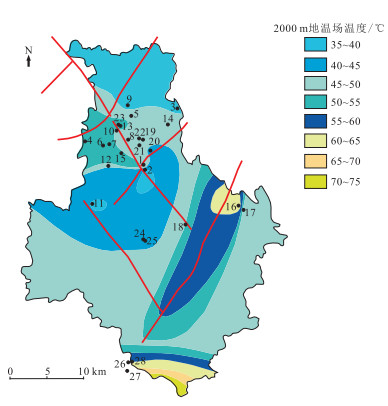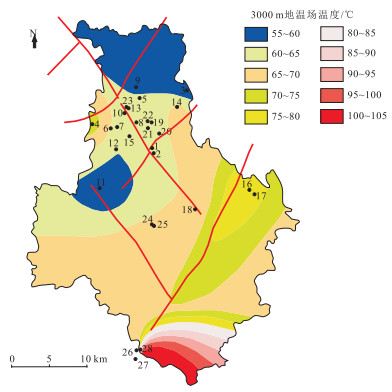Geothermal field in Tongzhou District of Beijing and its influencing factors
-
摘要:
在收集整理大量地热井温度资料的基础上,系统分析了北京通州地区现今地温场特征,划分了地热异常区,并进一步估算了1000~3000 m埋深处的地层温度。研究表明,研究区现今地温梯度为1.34~3.12℃/100 m,平均值为1.88℃/100 m。大地热流值分布范围为47.1~75.9 mW/m2,平均值为63.2 mW/m2,其热流状态较好。在垂向上,研究区1000 m埋深处整体温度均超30℃,2000 m时高温异常区温度超60℃,3000 m时高温异常区温度超80℃。根据深部地层温度估算,在研究区的南部及东南部具有2处高温异常区,地温场分布形态与区域内主要断裂走向基本一致,主要受区域地质构造控制,岩石性质为地温场分布的重要影响因素。
Abstract:Based on a large number of geothermal well temperature data, the distribution of the current geothermal field in Tongzhou District of Beijing is systematically analyzed, the geothermal anomaly area is divided, and the formation temperature at the depth of 1000~3000 m is further estimated. The results show that the current geothermal gradient ranges from 1.34 ℃/100 m to 3.12 ℃/100 m with an average of 1.88 ℃/100 m. Terrestrial heat flow values range from 47.1 mW/m2 to 75.9 mW/m2 with an average of 63.2 mW/m2. Vertically, the estimated temperature in the study area is over 30 ℃ at depth of 1000 m, the temperature of the high temperature abnormal area is over 60 ℃ at 2000 m, and over 80 ℃ at 3000 m. According to the estimation of deep formation temperature, there exist two high temperature anomaly areas in its south and southeast. Controlled by regional geological structure, the distribution pattern of geothermal field is basically consistent with the strike of regional main faults. In addition, the lithology is also one of the important influencing factors.
-

-
表 1 地热井地温梯度计算结果
Table 1. Geothermal gradients of geothermal well
地热井序号 成井深度/m 盖层深度/m 测温井段/m T/℃ G/(℃·100 m-1) G′/(℃·100 m-1) 1 811 0~445 100~800 29 1.95 1.81 2 642 0~473 100~600 28 2.46 3.16 3 1827 203~589 340~1800 43 1.64 2.18 4 2500 864~1418 1000~2417 62.5 2.03 2.16 5 2679 515~1065 1500~2670 56.8 1.62 - 6 2213 583~1108 1500~2210 53.2 1.80 - 7 2203 464~1049 1100~2200 53.8 1.83 - 8 2699 277~729 300~2670 57.1 1.63 1.84 9 2509 680~1225 100~2460 53.1 1.61 2.03 10 2480 439~979 1500~2400 55.34 1.74 4.09 11 2405 470~792 100~2350 45.2 1.34 1.10 12 2400 297~677 100~2400 51.5 1.58 1.24 13 2505 490~1073 100~2500 58.2 1.79 2.61 14 2106 926.5~1005 100~2100 49.89 1.73 2.32 15 2468 302~712 100~2400 57.1 1.82 3.38 16 3203 2404~2740 50~3200 84 2.21 1.66 17 3589 2817~3180 300~3425 89.5 2.22 2.17 18 2800 570~1086 50~2800 63.5 1.79 0.78 19 3001 255~618 100~3000 62.983 1.65 1.83 20 2800 0~478 100~2800 53.98 1.44 1.82 21 2800 - 300~2800 56.74 1.54 - 22 3000 - 286~3000 58.53 1.50 - 23 2204 504~1105 50~2190 53.7 1.84 2.91 24 2106 610~980 100~2100 45.94 1.54 0.46 25 2500 592~842 100~2500 51.4 1.51 0.76 26 3600 - 50~3600 116.4 2.87 - 27 3000 - 50~3000 97.61 2.82 - 28 3332 - 50~3330 116.9 3.12 - 注:T表示井底温度;G表示地热井地温梯度;G′表示盖层段地温梯度 -
[1] 王均, 黄尚瑶, 黄歌山. 中国地温分布的基本特征[M]. 北京: 地震出版社, 1990, 26: 80-100.
[2] 蔺文静, 刘志明, 王婉丽, 等. 中国地热资源及其潜力评估[J]. 中国地质, 2013, 40(1): 312-321. doi: 10.3969/j.issn.1000-3657.2013.01.021
[3] 卫万顺, 郑桂森, 栾英波. 北京平原区浅层地温场特征及其影响因素研究[J]. 中国地质, 2010, 37(6): 1733-1739. doi: 10.3969/j.issn.1000-3657.2010.06.019
[4] 陈晓冬, 金旭, 管彦武, 等. 长春地区地表温度日变、年变对地温测量的影响[J]. 地球物理学进展, 2006, (3): 1008-1011. doi: 10.3969/j.issn.1004-2903.2006.03.047
[5] 栾英波, 郑桂森, 卫万顺. 北京平原区粉质粘土热导率影响因素实验研究[J]. 中国地质, 2013, 40(3): 981-988. doi: 10.3969/j.issn.1000-3657.2013.03.028
[6] 于仲坤, 赵洪, 刁慧, 等. 东海陆架盆地丽水凹陷热演化模拟及现今地温场特征[J]. 海洋地质与第四纪地质, 2020, 40(2): 124-134. https://www.cnki.com.cn/Article/CJFDTOTAL-HYDZ202002013.htm
[7] 周阳, 穆根胥, 张卉, 等. 关中盆地地温场划分及其地质影响因素[J]. 中国地质, 2017, 44(5): 1017-1026. https://www.cnki.com.cn/Article/CJFDTOTAL-DIZI201705014.htm
[8] 柏崇伟, 孙志国, 金洪文, 等. 陇东盆地地热系统地温场特征及平凉地热勘查评价[J]. 甘肃地质, 2017, 26(1): 74-80. https://www.cnki.com.cn/Article/CJFDTOTAL-GSDZ201701011.htm
[9] 李文, 孔祥军, 袁利娟, 等. 北京通州地区地热井酸化压裂增灌试验研究[J]. 城市地质, 2019, 14(4): 43-48. doi: 10.3969/j.issn.1007-1903.2019.04.008
[10] 高剑, 张进平, 孔祥军, 等. 北京通州地区深部地热井间的影响分析[J]. 城市地质, 2017, 12(4): 72-75. doi: 10.3969/j.issn.1007-1903.2017.04.014
[11] 蔡向民, 栾英波, 郭高轩, 等. 北京平原地区地质系统[J]. 城市地质, 2009, 4(3): 6-12. doi: 10.3969/j.issn.1007-1903.2009.03.002
[12] 宾德智, 刘久荣, 王小玲. 北京地热资源[C]//北京地热国际研讨会论文集, 2002: 169-177.
[13] 北京地质局. 北京市区域地质志[M]. 北京: 地质出版社, 1991: 213-260.
[14] 蔡向民, 郭高轩, 栾英波, 等. 北京山前平原区第四系三维结构调查方法研究[J]. 地质学报, 2009, 83(7): 1047-1057. doi: 10.3321/j.issn:0001-5717.2009.07.012
[15] 陈墨香. 华北地热[M]. 北京: 科学出版社, 1988: 1-100.
[16] 姜光政, 高堋, 饶松, 等. 中国大陆地区大地热流数据汇编(第四版)[J]. 地球物理学报, 2016, 59(8): 2892-2910. https://www.cnki.com.cn/Article/CJFDTOTAL-DQWX201608015.htm
[17] 徐世光, 郭远生. 地热学基础[M]. 北京: 科技出版社, 2009: 15.
[18] 雷晓东, 胡圣标, 李娟, 等. 北京平原区西北部大地热流与深部地温分布特征[J]. 地球物理学报, 2018, 61(9): 3735-3748. https://www.cnki.com.cn/Article/CJFDTOTAL-DQWX201809021.htm
[19] 汪集旸, 胡圣标, 庞忠和, 等. 中国大陆干热岩地热资源潜力评估[J]. 科技导报, 2012, 30(32): 25-31. doi: 10.3981/j.issn.1000-7857.2012.32.002
[20] 柯柏林, 林天懿, 李文, 等. 北京西山谷积山背斜地热系统成因模式及远景区预测[J]. 地质通报, 2019, 38(8): 1378-1385. https://www.cnki.com.cn/Article/CJFDTOTAL-ZQYD201908015.htm
[21] 阎敦实, 于英太. 京津冀油区地热资源评价与利用[M]. 武汉: 中国地质大学出版社, 2000: 19.
[22] 胡玉禄, 胡红文, 邱希青, 等. 华北地温场垂向变化[C]//山东省科学技术协会. 地质与可持续发展——华东六省一市地学科技论坛文集. 山东省科学技术协会, 2003: 3.
[23] 邱楠生. 中国西北部盆地岩石热导率和生热率特征[J]. 地质科学, 2002, (2): 196-206. https://www.cnki.com.cn/Article/CJFDTOTAL-DZKX200202006.htm
-



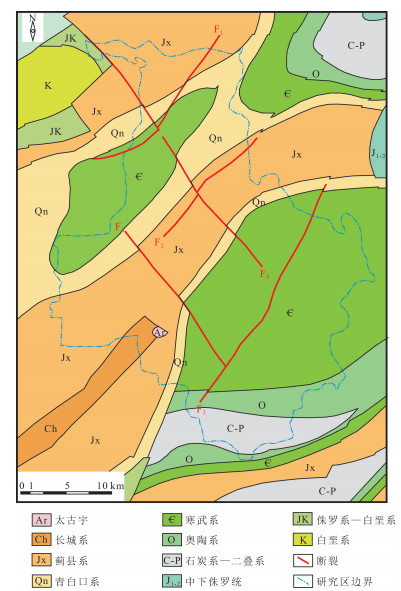
 下载:
下载:
